Teaching Digital Sustainability in Higher Education from a Transdisciplinary Perspective
Abstract
:1. Introduction
2. Related Work
2.1. The Sustainable Development Goals
2.2. Teaching Sustainability in Higher Educational Settings
3. Teaching Framework
4. Case Study
4.1. Description of the Student Cohort
4.2. Explorative Results of the Student Groups
4.3. Explorative Cluster Analysis of Student Groups
- Efficient allocation: SDGs 7–9; SDGs 11–12;
- Fair distribution: SDGs 1–5; SDG 10; SDGs 16–17;
- Sustainable scale: SDG 6; SDGs 13–15
5. Discussion
5.1. Target Group and Challenges to the Framework
- Are there specific hurdles in transferring the presented framework from the postgraduate sector towards classical bachelor’s programmes?
- 2.
- Are there any constraints considering prerequisites to execute the proposed framework?
- 3.
- What challenges arose during the individual steps of the framework and how can they potentially be mitigated?
5.2. Extensions to the Framework
- 1.
- An inherently positive view of digitalization was presented, as a problem solver for sustainability. How about the dark side of digitalization when digital transformation is a problem by itself?
- 2.
- A micro-level view of digital transformation as an organization-level concern was presented, unlike a system-level transition which, due to the broad adoption of digital technologies, alters social, economic, political, etc. behaviour on a large scale. Can the presented work lend itself to generalization from the micro to the macro view?
- 3.
- The aspect of micro-sustainability is also viewed from inside an organization. Could an external consumer/partner/supplier view complement the internal view?
- 4.
- Roleplaying could be tried within the framework, including consumer, provider, administrator, policymaker, and other roles, depending on the students’ affiliations and professional functions.
- 5.
- Could the national-level SDG review constitute part of the macro/system view on sustainability?
6. Conclusions
Author Contributions
Funding
Institutional Review Board Statement
Informed Consent Statement
Data Availability Statement
Acknowledgments
Conflicts of Interest
References
- Brandt, P.; Ernst, A.; Gralla, F.; Luederitz, C.; Lang, D.J.; Newig, J.; Reinert, F.; Abson, D.J.; von Wehrden, H. A review of transdisciplinary research in sustainability science. Ecol. Econ. 2013, 92, 1–15. [Google Scholar] [CrossRef]
- Weiss, M.; Barth, M. Global research landscape of sustainability curricula implementation in higher education. Int. J. Sustain. High. Educ. 2019, 20, 570–589. [Google Scholar] [CrossRef]
- Tassone, V.C.; O’Mahony, C.; McKenna, E.; Eppink, H.J.; Wals, A.E.J. (Re-)designing higher education curricula in times of systemic dysfunction: A responsible research and innovation perspective. High. Educ. 2018, 76, 337–352. [Google Scholar] [CrossRef] [Green Version]
- Sánchez-Carracedo, F.; Sureda Carbonell, B.; Moreno-Pino, F.M. Analysis of sustainability presence in Spanish higher education. IJSHE 2020, 21, 393–412. [Google Scholar] [CrossRef]
- Sánchez Carracedo, F.; Soler, A.; Martín, C.; López, D.; Ageno, A.; Cabré, J.; Garcia, J.; Aranda, J.; Gibert, K. Competency Maps: An Effective Model to Integrate Professional Competencies Across a STEM Curriculum. J. Sci. Educ. Technol. 2018, 27, 448–468. [Google Scholar] [CrossRef]
- Van der Velden, M. Digitalisation and the UN Sustainable Development Goals: What role for design. IDA Interact. Des. Archit. 2018, 160–174. [Google Scholar]
- Hecker, A.; Huber, F. The Future of the Management of Innovation: Trends and Challenges. In Handbook of the Management of Creativity and Innovation: Theory and Practice; World Scientific: Hackensack, NJ, USA, 2017; pp. 331–346. [Google Scholar]
- Dacko, S.G.; Claudy, M.; Garcia, R.; Wilner, S.J.S. Sustainability Orientation as a Driver of Innovation within Firms. In Proceedings of the ISPIM Conference Proceedings, Helsinki, Finland, 16–19 June 2013; The International Society for Professional Innovation Management (ISPIM): Manchester, UK, 2013. [Google Scholar]
- Department of Economic and Social Affairs. THE 17 GOALS | Sustainable Development. Available online: https://sdgs.un.org/goals (accessed on 29 September 2021).
- Dhahri, S.; Omri, A. Entrepreneurship contribution to the three pillars of sustainable development: What does the evidence really say? World Dev. 2018, 106, 64–77. [Google Scholar] [CrossRef] [Green Version]
- Lindgreen, A.; Swaen, V. Corporate Social Responsibility. Int. J. Manag. Rev. 2010, 12, 1–7. [Google Scholar] [CrossRef] [Green Version]
- Lobschat, L.; Mueller, B.; Eggers, F.; Brandimarte, L.; Diefenbach, S.; Kroschke, M.; Wirtz, J. Corporate digital responsibility. J. Bus. Res. 2021, 122, 875–888. [Google Scholar] [CrossRef]
- Sherren, K. A history of the future of higher education for sustainable development. Environ. Educ. Res. 2008, 14, 238–256. [Google Scholar] [CrossRef]
- Scholz, R.W.; Binder, C.R. Environmental Literacy in Science and Society: From Knowledge to Decisions; Cambridge University Press: Cambridge, UK, 2011. [Google Scholar]
- Klein, J.T.; Grossenbacher-Mansuy, W.; Häberli, R.; Bill, A.; Scholz, R.W.; Welti, M. Transdisciplinarity: Joint Problem Solving Among Science, Technology, and Society: An Effective Way for Managing Complexity; Springer Science & Business Media, Birkhäuser: Basel, Switzerland, 2001. [Google Scholar]
- Renn, O. Transdisciplinarity: Synthesis towards a modular approach. Futures 2021, 130, 102744. [Google Scholar] [CrossRef]
- Widener, J.M.; Gliedt, T.; Tziganuk, A. Assessing sustainability teaching and learning in geography education. IJSHE 2016, 17, 698–718. [Google Scholar] [CrossRef]
- Chen, M.; Wu, Y.; Tsai, K. Building an Industry-Oriented Business Sustainability Curriculum in Higher Education. Sustainability 2018, 10, 4698. [Google Scholar] [CrossRef] [Green Version]
- Clifford, V.; Montgomery, C. Designing an internationationalised curriculum for higher education: Embracing the local and the global citizen. High. Educ. Res. Dev. 2017, 36, 1138–1151. [Google Scholar] [CrossRef]
- Ceulemans, K.; de Prins, M. Teacher’s manual and method for SD integration in curricula. J. Clean. Prod. 2010, 18, 645–651. [Google Scholar] [CrossRef] [Green Version]
- Dagiliūtė, R.; Liobikienė, G. University contributions to environmental sustainability: Challenges and opportunities from the Lithuanian case. J. Clean. Prod. 2015, 108, 891–899. [Google Scholar] [CrossRef]
- Sterling, S.; Thomas, I. Education for sustainability: The role of capabilities in guiding university curricula. Int. J. Innov. Sustain. Dev. 2007, 1, 349–370. [Google Scholar] [CrossRef]
- Sidiropoulos, E. The personal context of student learning for sustainability: Results of a multi-university research study. J. Clean. Prod. 2018, 181, 537–554. [Google Scholar] [CrossRef]
- Ferrer-Balas, D.; Lozano, R.; Huisingh, D.; Buckland, H.; Ysern, P.; Zilahy, G. Going beyond the rhetoric: System-wide changes in universities for sustainable societies. J. Clean. Prod. 2010, 18, 607–610. [Google Scholar] [CrossRef]
- Fehling, M.; Nelson, B.D.; Venkatapuram, S. Limitations of the Millennium Development Goals: A literature review. Glob. Public Health 2013, 8, 1109–1122. [Google Scholar] [CrossRef] [PubMed] [Green Version]
- Federal Chancellery of Austria. Nachhaltige Entwicklung—Agenda 2030/SDGs. Available online: https://www.bundeskanzleramt.gv.at/. (accessed on 26 October 2021).
- Setó-Pamies, D.; Papaoikonomou, E. Sustainable Development Goals: A Powerful Framework for Embedding Ethics, CSR, and Sustainability in Management Education. Sustainability 2020, 12, 1762. [Google Scholar] [CrossRef] [Green Version]
- Weybrecht, G. From challenge to opportunity—Management education’s crucial role in sustainability and the Sustainable Development Goals—An overview and framework. Int. J. Manag. Educ. 2017, 15, 84–92. [Google Scholar] [CrossRef]
- Badea, L.; Șerban-Oprescu, G.L.; Dedu, S.; Piroșcă, G.I. The Impact of Education for Sustainable Development on Romanian Economics and Business Students’ Behavior. Sustainability 2020, 12, 8169. [Google Scholar] [CrossRef]
- Hoinle, B.; Roose, I.; Shekhar, H. Creating Transdisciplinary Teaching Spaces. Cooperation of Universities and Non-University Partners to Design Higher Education for Regional Sustainable Transition. Sustainability 2021, 13, 3680. [Google Scholar] [CrossRef]
- Gómez-Ruiz, M.-L.; Morales-Yago, F.-J.; de Lázaro-Torres, M.-L. Outdoor Education, the Enhancement and Sustainability of Cultural Heritage: Medieval Madrid. Sustainability 2021, 13, 1106. [Google Scholar] [CrossRef]
- Molina-Torres, M.-P. Eco-Didactic Project for the Knowledge of a Community Museum. Sustainability 2021, 13, 3918. [Google Scholar] [CrossRef]
- Collazo Expósito, L.M.; Granados Sánchez, J. Implementation of SDGs in University Teaching: A Course for Professional Development of Teachers in Education for Sustainability for a Transformative Action. Sustainability 2020, 12, 8267. [Google Scholar] [CrossRef]
- Braßler, M.; Sprenger, S. Fostering Sustainability Knowledge, Attitudes, and Behaviours through a Tutor-Supported Interdisciplinary Course in Education for Sustainable Development. Sustainability 2021, 13, 3494. [Google Scholar] [CrossRef]
- Berasategi, N.; Aróstegui, I.; Jaureguizar, J.; Aizpurua, A.; Guerra, N.; Arribillaga-Iriarte, A. Interdisciplinary Learning at University: Assessment of an Interdisciplinary Experience Based on the Case Study Methodology. Sustainability 2020, 12, 7732. [Google Scholar] [CrossRef]
- Mets, T.; Holbrook, J.; Läänelaid, S. Entrepreneurship Education Challenges for Green Transformation. Adm. Sci. 2021, 11, 15. [Google Scholar] [CrossRef]
- Hermann, R.R.; Bossle, M.B. Bringing an entrepreneurial focus to sustainability education: A teaching framework based on content analysis. J. Clean. Prod. 2020, 246, 119038. [Google Scholar] [CrossRef]
- Derler, H.; Berner, S.; Grach, D.; Posch, A.; Seebacher, U. Project-Based Learning in a Transinstitutional Research Setting: Case Study on the Development of Sustainable Food Products. Sustainability 2020, 12, 233. [Google Scholar] [CrossRef] [Green Version]
- Duarte, J.; Robert Nogueira, J. From the Hidden Protest of Students towards Problem-Based Learning. Educ. Sci. 2019, 9, 215. [Google Scholar] [CrossRef] [Green Version]
- Scholz, R.W.; Tietje, O. Embedded Case Study Methods: Integrating Quantitative and Qualitative Knowledge; SAGE Publications Inc: Thousand Oaks, USA, 2002. [Google Scholar]
- Hernández-Barco, M.; Sánchez-Martín, J.; Blanco-Salas, J.; Ruiz-Téllez, T. Teaching Down to Earth—Service-Learning Methodology for Science Education and Sustainability at the University Level: A Practical Approach. Sustainability 2020, 12, 542. [Google Scholar] [CrossRef] [Green Version]
- Mooney, L.A.; Edwards, B. Experiential Learning in Sociology: Service Learning and Other Community-Based Learning Initiatives. Teach. Sociol. 2001, 29, 181. [Google Scholar] [CrossRef]
- Menon, S.; Suresh, M. Synergizing education, research, campus operations, and community engagements towards sustainability in higher education: A literature review. IJSHE 2020, 21, 1015–1051. [Google Scholar] [CrossRef]
- Lux, A.; Schäfer, M.; Bergmann, M.; Jahn, T.; Marg, O.; Nagy, E.; Ransiek, A.-C.; Theiler, L. Societal effects of transdisciplinary sustainability research—How can they be strengthened during the research process? Environ. Sci. Policy 2019, 101, 183–191. [Google Scholar] [CrossRef]
- Trencher, G.; Yarime, M.; McCormick, K.B.; Doll, C.N.H.; Kraines, S.B. Beyond the third mission: Exploring the emerging university function of co-creation for sustainability. Sci Public Policy 2014, 41, 151–179. [Google Scholar] [CrossRef] [Green Version]
- Nagy, E.; Ransiek, A.; Schäfer, M.; Lux, A.; Bergmann, M.; Jahn, T.; Marg, O.; Theiler, L. Transfer as a reciprocal process: How to foster receptivity to results of transdisciplinary research. Environ. Sci. Policy 2020, 104, 148–160. [Google Scholar] [CrossRef]
- Nölting, B.; Molitor, H.; Reimann, J.; Skroblin, J.-H.; Dembski, N. Transfer for Sustainable Development at Higher Education Institutions—Untapped Potential for Education for Sustainable Development and for Societal Transformation. Sustainability 2020, 12, 2952. [Google Scholar] [CrossRef] [Green Version]
- Rienties, B.; Alcott, P.; Jindal-Snape, D. To Let Students Self-Select or Not: That Is the Question for Teachers of Culturally Diverse Groups. J. Stud. Int. Educ. 2014, 18, 64–83. [Google Scholar] [CrossRef] [Green Version]
- Corral de Zubielqui, G.; Lindsay, N.; Lindsay, W.; Jones, J. Knowledge quality, innovation and firm performance: A study of knowledge transfer in SMEs. Small Bus. Econ. 2019, 53, 145–164. [Google Scholar] [CrossRef]
- Dyson, R.G. Strategic development and SWOT analysis at the University of Warwick. Eur. J. Oper. Res. 2004, 152, 631–640. [Google Scholar] [CrossRef]
- Gupa, A. Environment & PEST analysis: An approach to the external business environment. Int. J. Mod. Soc. Sci. 2013, 2, 34–43. [Google Scholar]
- Yüksel, I. Developing a multi-criteria decision making model for PESTEL analysis. Int. J. Bus. Manag. 2012, 7, 52. [Google Scholar] [CrossRef] [Green Version]
- Kaplan, R.S.; Norton, D.P. The balanced scorecard: Measures that drive performance. Harv. Bus. Rev. 2005, 83, 71–79. [Google Scholar]
- Johnson, S.C. Hierarchical clustering schemes. Psychometrika 1967, 32, 241–254. [Google Scholar] [CrossRef] [PubMed]
- Costanza, R.; Daly, L.; Fioramonti, L.; Giovannini, E.; Kubiszewski, I.; Mortensen, L.F.; Pickett, K.E.; Ragnarsdottir, K.V.; de Vogli, R.; Wilkinson, R. Modelling and measuring sustainable wellbeing in connection with the UN Sustainable Development Goals. Ecol. Econ. 2016, 130, 350–355. [Google Scholar] [CrossRef]
- R: A Language and Environment for Statistical Computing. 2013. Available online: http://r.meteo.uni.wroc.pl/web/packages/dplR/vignettes/intro-dplR.pdf (accessed on 26 October 2021).
- Kaufman, L.; Rousseeuw, P.J. Finding Groups in Data: An Introduction to Cluster Analysis; John Wiley & Sons: Hoboken, NJ, USA, 2005. [Google Scholar]
- Maechler, M.; Rousseeuw, P.; Struyf, A.; Hubert, M.; Hornik, K.; Studer, M. Package ‘Cluster’. Available online: https://CRAN.R-project.org/package=cluster (accessed on 26 October 2021).
- Mariñas-Collado, I.; Frutos Bernal, E.; Santos Martin, M.T.; Del Martín Rey, A.; Casado Vara, R.; Gil-González, A.B. A Mathematical Study of Barcelona Metro Network. Electronics 2021, 10, 557. [Google Scholar] [CrossRef]
- Charrad, M.; Ghazzali, N.; Boiteau, V.; Niknafs, A. NbClust: An R Package for Determining the Relevant Number of Clusters in a Data Set. J. Stat. Soft. 2014, 61, 1–36. [Google Scholar] [CrossRef] [Green Version]
- Scholz, R.W.; Czichos, R.; Parycek, P.; Lampoltshammer, T.J. Organizational vulnerability of digital threats: A first validation of an assessment method. Eur. J. Oper. Res. 2020, 282, 627–643. [Google Scholar] [CrossRef]
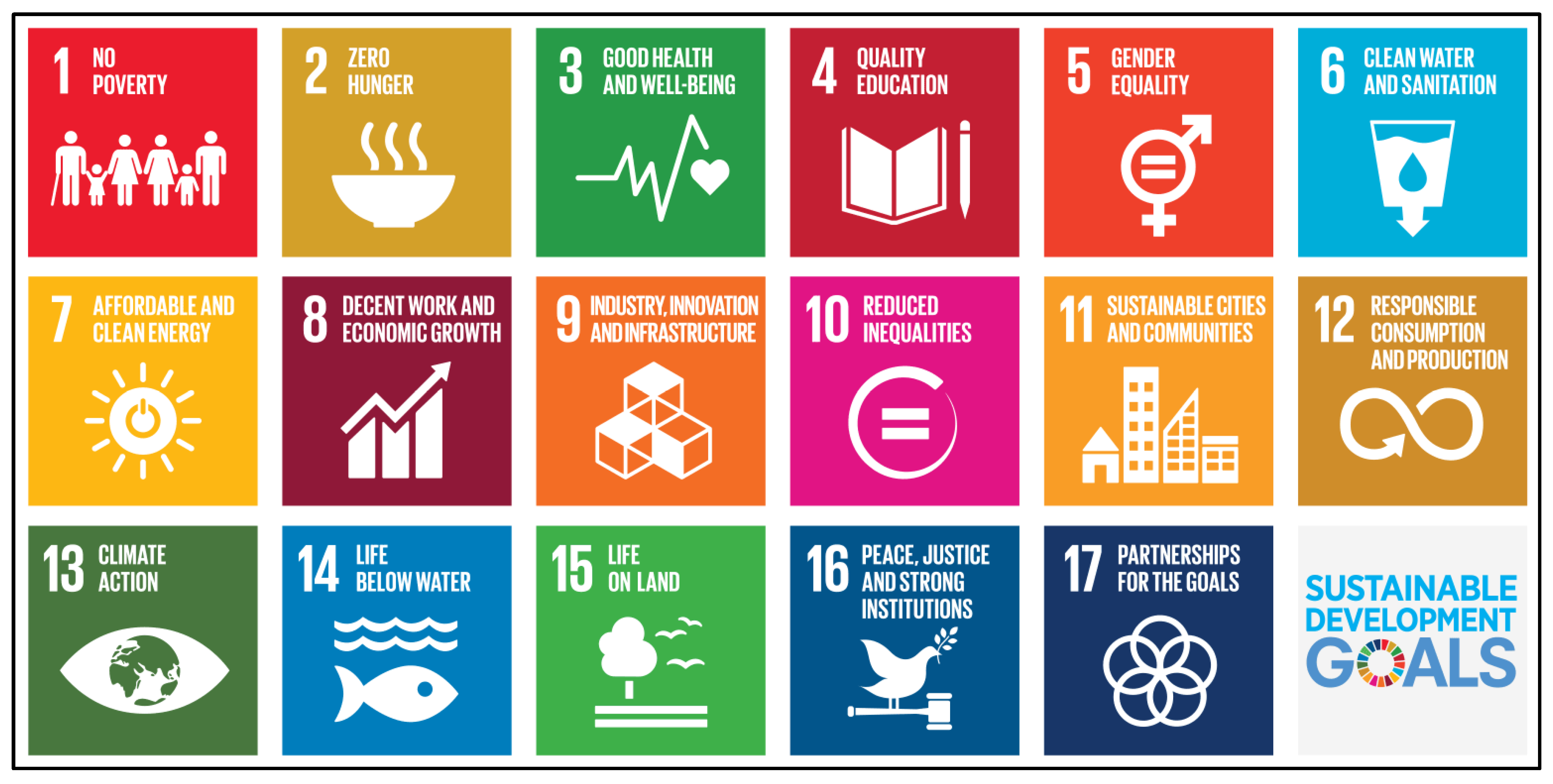
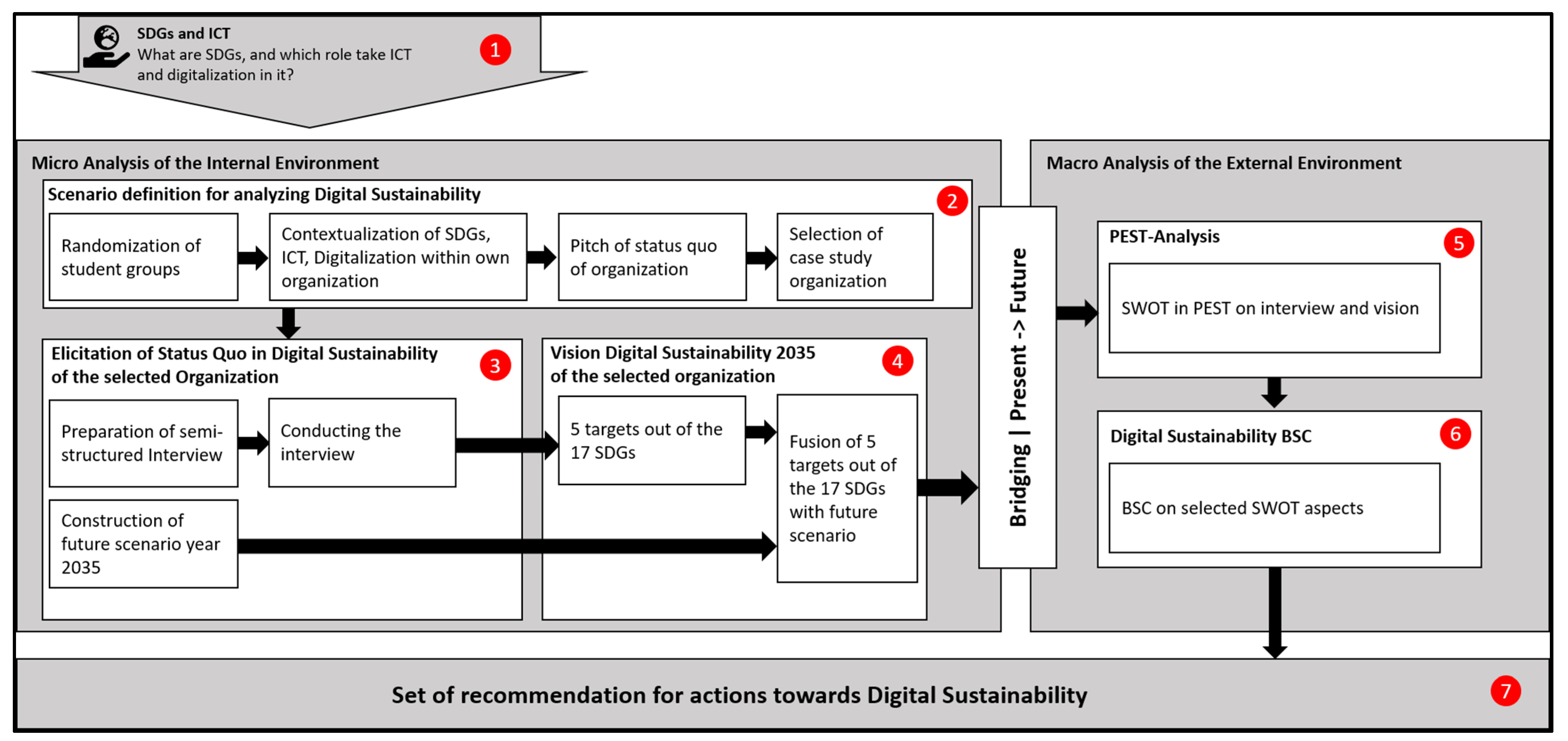
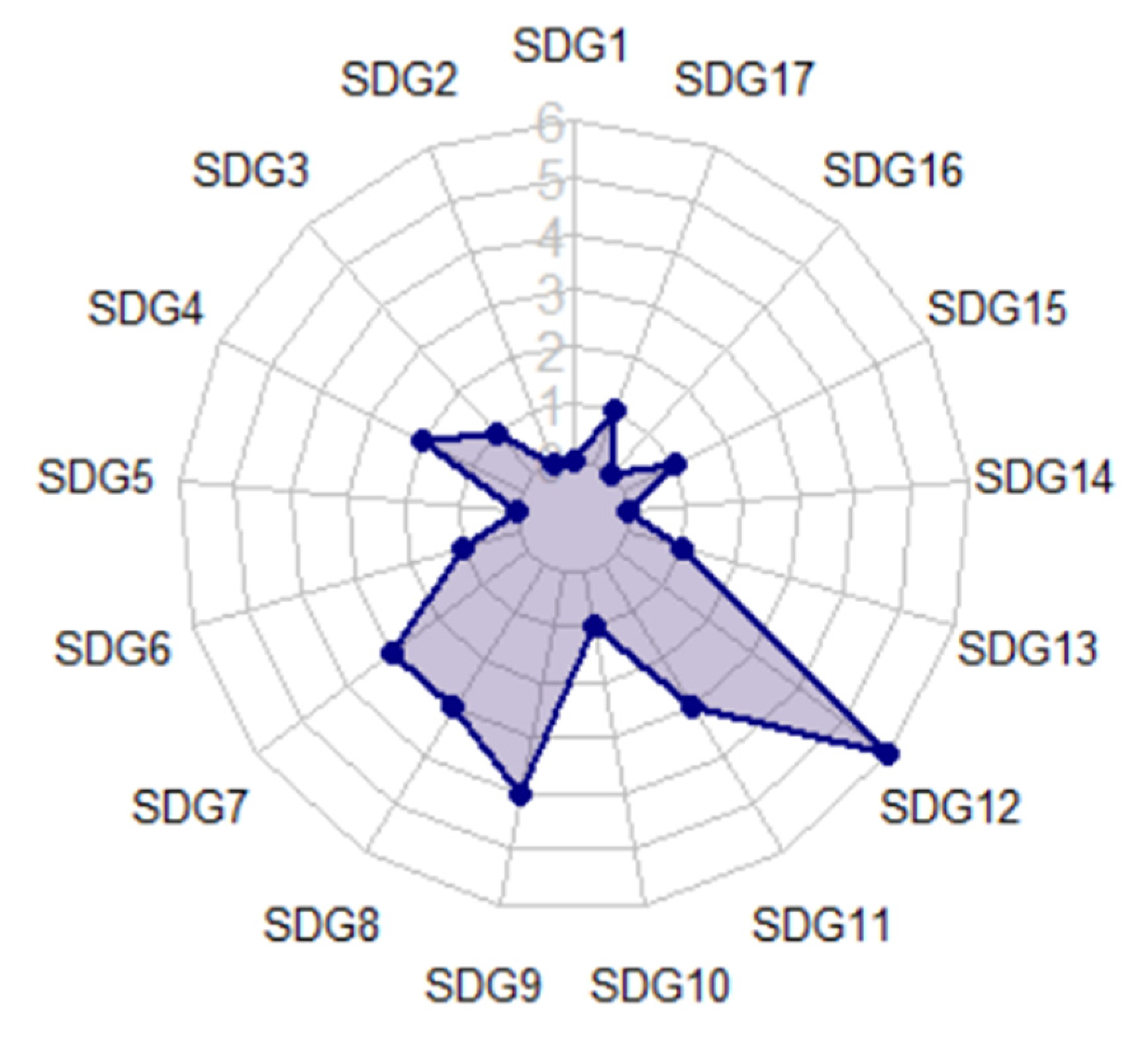
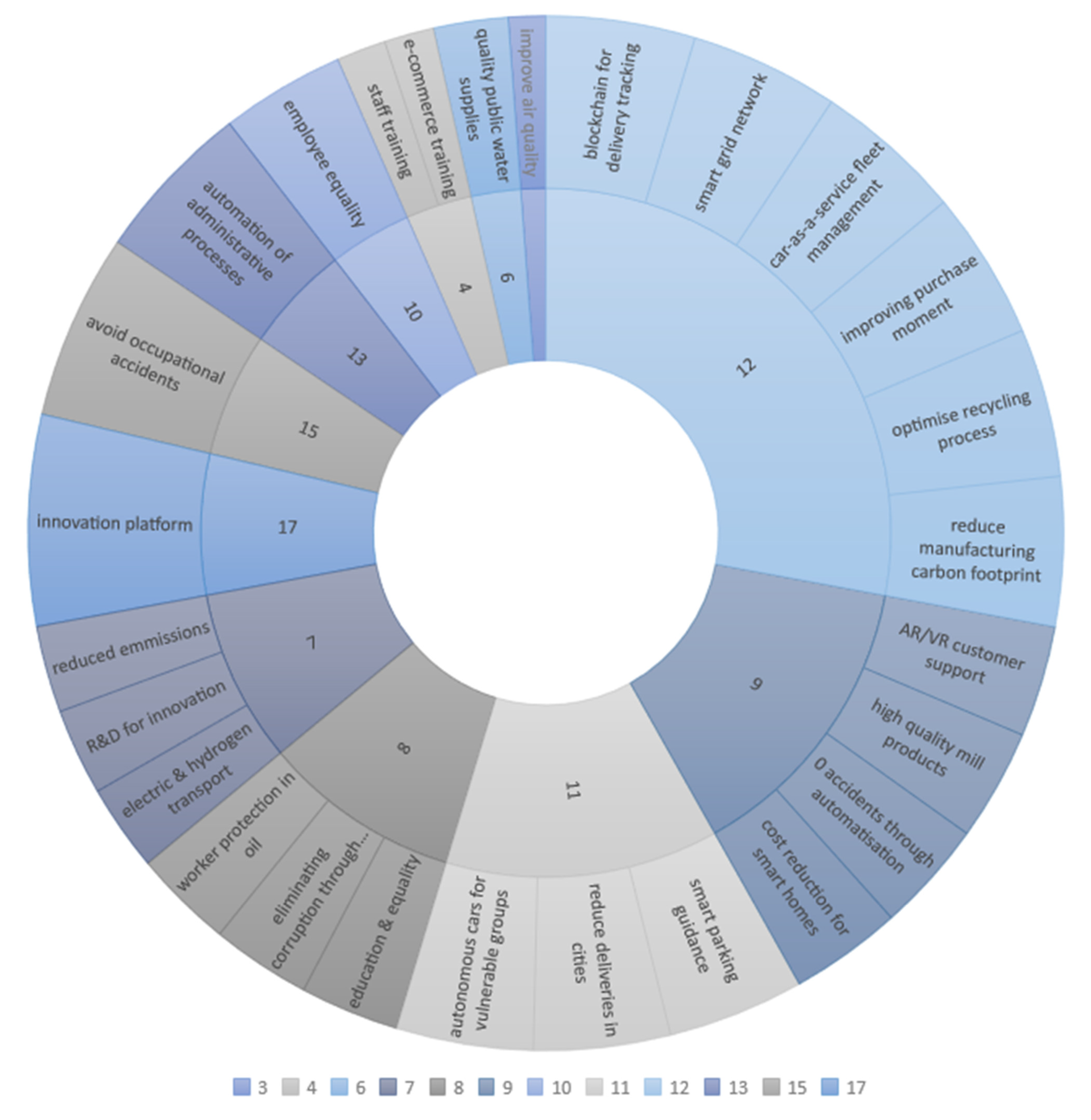
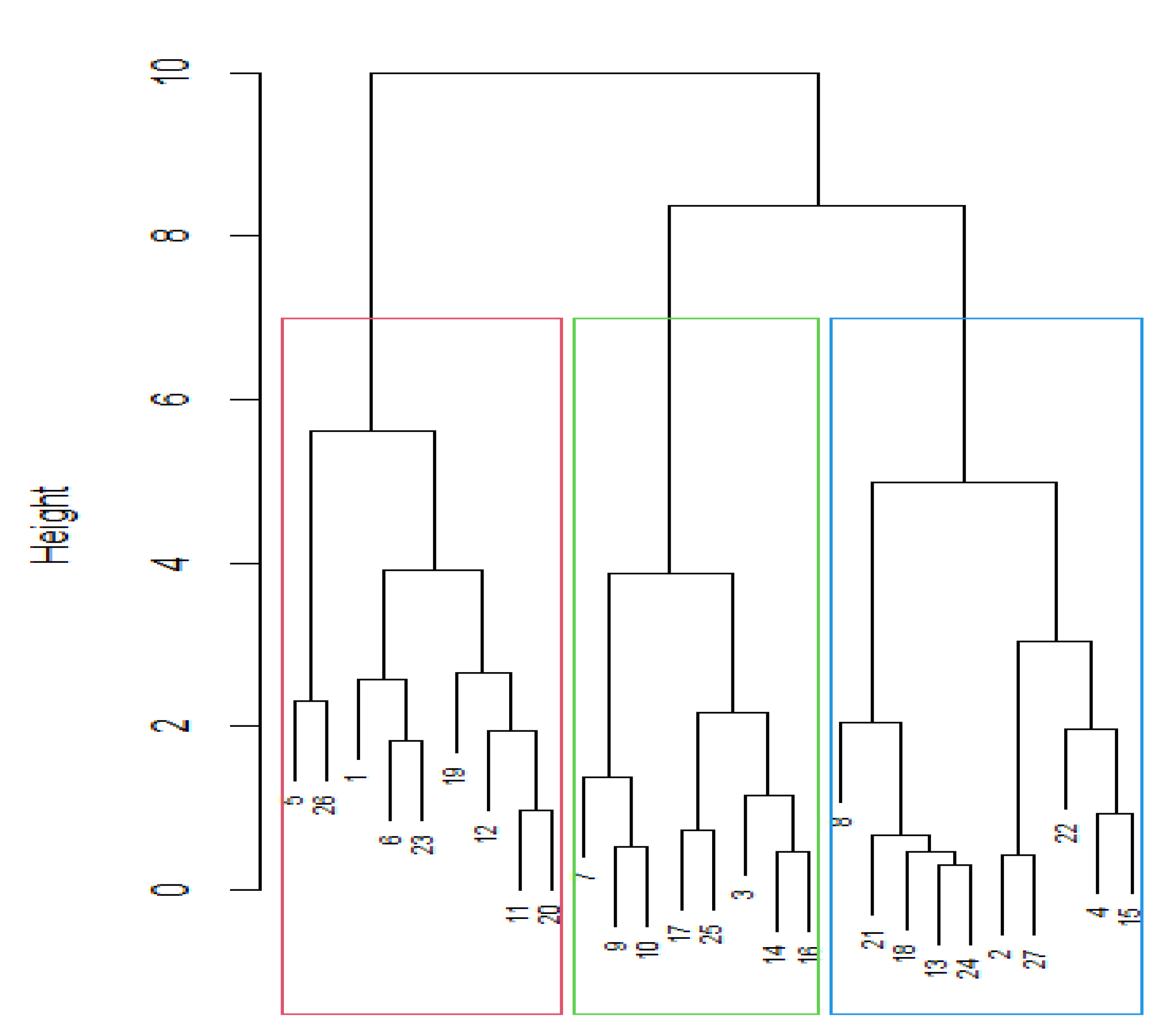
| Year 1 | Year 2 | Total | % of Total | ||
|---|---|---|---|---|---|
| No. of students per class | 75 | 42 | 117 | 100% | |
| Program | DCG => MBA programme | 10 | 4 | 14 | 12% |
| MIT => Master’s programme (MSc) | 65 | 38 | 103 | 88% | |
| Nationality | German | 23 | 20 | 43 | 37% |
| Austrian | 52 | 22 | 74 | 63% | |
| Gender | Male | 68 | 35 | 103 | 88% |
| Female | 7 | 7 | 14 | 12% | |
| Age (in years) | 24–30 | 19 | 13 | 32 | 27% |
| 31–36 | 14 | 13 | 27 | 23% | |
| 37–42 | 15 | 9 | 24 | 21% | |
| 43–48 | 21 | 6 | 27 | 23% | |
| >48 | 6 | 1 | 7 | 6% | |
| Highest completed level of pre-education | Apprenticeship | 37 | 24 | 61 | 52% |
| Professional school | 3 | 0 | 3 | 3% | |
| A-levels | 27 | 13 | 40 | 34% | |
| University (bachelor’s and/or master’s degree) | 8 | 5 | 13 | 11% | |
| Years of professional experience | <=5 | 3 | 5 | 8 | 7% |
| 6–10 J | 11 | 9 | 20 | 17% | |
| 11–15J | 22 | 8 | 30 | 26% | |
| 16–20J | 14 | 10 | 24 | 21% | |
| 21–25 J | 14 | 8 | 22 | 19% | |
| 26–30 J | 7 | 2 | 9 | 8% | |
| >30 J | 4 | 0 | 4 | 3% | |
| Years of leadership/management experience | None | 8 | 9 | 17 | 15% |
| <2 | 0 | 1 | 1 | 1% | |
| 2–3 | 9 | 11 | 20 | 17% | |
| 4–5 | 12 | 3 | 15 | 13% | |
| 6–7 | 2 | 5 | 7 | 6% | |
| >7 | 44 | 13 | 57 | 49% | |
| Hierarchy level | Employee | 41 | 25 | 66 | 56% |
| Lower management/team lead | 11 | 7 | 18 | 15% | |
| Middle management | 12 | 9 | 21 | 18% | |
| Self-employed/chief executive | 7 | 1 | 8 | 7% | |
| Top management/C level | 4 | 0 | 4 | 3% | |
| The economic sector of employing company or organization | Secondary | 37 | 28 | 65 | 56% |
| Tertiary | 38 | 14 | 52 | 44% | |
| ISIC classification of employer’s economic activity | 10. Information and communication | 16 | 2 | 18 | 15% |
| 11. Financial and insurance activities | 2 | 1 | 3 | 3% | |
| 13. Professional, scientific and technical activities | 7 | 7 | 14 | 12% | |
| 14. Administrative and support service activities | 2 | 0 | 2 | 2% | |
| 15. Public administration and defence; compulsory social security | 3 | 2 | 5 | 4% | |
| 16. Education | 2 | 0 | 2 | 2% | |
| 17. Human health and social work activities | 2 | 0 | 2 | 2% | |
| 3. Manufacturing | 37 | 28 | 65 | 56% | |
| 7. Wholesale and retail trade; repair of motor vehicles and motorcycles | 2 | 1 | 3 | 3% | |
| 8. Transportation and storage | 2 | 1 | 3 | 3% |
| GROUP ID | SECTOR | ISIC | EFS | AGE | EDU LVL | EXP OVERALL | EXP LEAD | CLUSTER |
|---|---|---|---|---|---|---|---|---|
| 1 | 3 | 7 | 2 | 43 | 0 | 22 | 16 | 1 |
| 5 | 3 | 15 | 3 | 39 | 1 | 8 | 7 | 1 |
| 6 | 3 | 8 | 1 | 30 | 0 | 15 | 9 | 1 |
| 11 | 3 | 11 | 1 | 43 | 1 | 13 | 7 | 1 |
| 12 | 3 | 10 | 1 | 30 | 1 | 8 | 0 | 1 |
| 19 | 3 | 10 | 1 | 41 | 1 | 25 | 0 | 1 |
| 20 | 3 | 8 | 1 | 39 | 1 | 11 | 0 | 1 |
| 23 | 3 | 13 | 1 | 39 | 0 | 18 | 0 | 1 |
| 26 | 3 | 15 | 3 | 31 | 0 | 11 | 11 | 1 |
| 2 | 2 | 3 | 1 | 30 | 0 | 11 | 5 | 2 |
| 4 | 2 | 3 | 2 | 30 | 0 | 9 | 7 | 2 |
| 8 | 2 | 3 | 2 | 30 | 1 | 10 | 7 | 2 |
| 13 | 2 | 3 | 1 | 26 | 1 | 6 | 0 | 2 |
| 15 | 2 | 3 | 2 | 34 | 0 | 14 | 5 | 2 |
| 18 | 2 | 3 | 1 | 28 | 1 | 9 | 3 | 2 |
| 21 | 2 | 3 | 1 | 24 | 1 | 5 | 3 | 2 |
| 22 | 2 | 3 | 3 | 28 | 0 | 7 | 3 | 2 |
| 24 | 2 | 3 | 1 | 26 | 1 | 8 | 5 | 2 |
| 27 | 2 | 3 | 1 | 27 | 0 | 11 | 3 | 2 |
| 3 | 2 | 3 | 1 | 37 | 0 | 17 | 5 | 3 |
| 7 | 2 | 3 | 1 | 36 | 1 | 18 | 7 | 3 |
| 9 | 2 | 3 | 1 | 44 | 1 | 24 | 7 | 3 |
| 10 | 2 | 3 | 1 | 42 | 1 | 21 | 0 | 3 |
| 14 | 2 | 3 | 1 | 43 | 0 | 21 | 7 | 3 |
| 16 | 2 | 3 | 1 | 44 | 0 | 18 | 13 | 3 |
| 17 | 2 | 3 | 1 | 45 | 0 | 30 | 13 | 3 |
| 25 | 2 | 3 | 1 | 45 | 0 | 25 | 3 | 3 |
| Step # | Content of Step | Problem Challenge/Open Point | Methods for Mitigation |
|---|---|---|---|
| 1 | Introduction of SDGs, ICT, and digitalization | the challenge of sustainability awareness | Involve senior students in peer exchange and mutual learning |
| 2 | Scenario definition | the challenge of scenario definition |
|
| 3 | Elicitation of status quo |
|
|
| 4 | Vision creation |
|
|
| 5 | PEST analysis | the challenge of going beyond financial aspects |
|
| 6 | Digital Sustainability BSC | the challenge of measuring what matters |
|
| 7 | Formulations of recommendations | the challenge of pitching the results |
|
Publisher’s Note: MDPI stays neutral with regard to jurisdictional claims in published maps and institutional affiliations. |
© 2021 by the authors. Licensee MDPI, Basel, Switzerland. This article is an open access article distributed under the terms and conditions of the Creative Commons Attribution (CC BY) license (https://creativecommons.org/licenses/by/4.0/).
Share and Cite
Lampoltshammer, T.J.; Albrecht, V.; Raith, C. Teaching Digital Sustainability in Higher Education from a Transdisciplinary Perspective. Sustainability 2021, 13, 12039. https://doi.org/10.3390/su132112039
Lampoltshammer TJ, Albrecht V, Raith C. Teaching Digital Sustainability in Higher Education from a Transdisciplinary Perspective. Sustainability. 2021; 13(21):12039. https://doi.org/10.3390/su132112039
Chicago/Turabian StyleLampoltshammer, Thomas J., Valerie Albrecht, and Corinna Raith. 2021. "Teaching Digital Sustainability in Higher Education from a Transdisciplinary Perspective" Sustainability 13, no. 21: 12039. https://doi.org/10.3390/su132112039
APA StyleLampoltshammer, T. J., Albrecht, V., & Raith, C. (2021). Teaching Digital Sustainability in Higher Education from a Transdisciplinary Perspective. Sustainability, 13(21), 12039. https://doi.org/10.3390/su132112039







